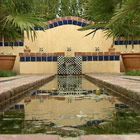The Alhambra, meaning red fortress, stands majestically on red clay hills to the east of Granada, in the south of Spain. It is considered to be the finest surviving medieval palace anywhere in the world and its gardens, patios and fountains have inspired gardening traditions that continue to this day.
History and religion
Built between 1333 and 1391 by the Sultans of the Nazarid, this palace was the last Moorish stronghold in Spain. The Alhambra was a fortress, a palace and an administrative centre for the Moors until 1492. Moorish architecture and gardens are not just beautiful, they also symbolise Islamic religion. Indeed, the Islamic word for garden means ‘Paradise’. The symbolism is most apparent in the Alhambra’s two famous patios: the Lion’s Patio and the Patio of the Myrtle Trees.
Adjoining the Alhambra is the Generalife, the Sultan’s summer palace. Here is a world famous patio that has inspired some of the finest water features around the world. The Patio de Acequia, (literally Patio of the Irrigation Ditch), is an enclosed garden with a 54x12m (162×4’) pool at its centre. The rows of fountains flanking either side of the pool are not Moorish but were added last century.
Lessons for Australia
The gardens of the Alhambra contain many perfumed plants including Japanese pittosporum (Pittosporum tobira), a bushy shrub or small tree with small creamy white flowers with a strong orange blossom fragrance. As well there are roses, mock orange and citrus trees. All would thrive in Australian gardens.
Who were the Moors?
The Moors who colonised parts of Spain came from North Africa, from present day Morocco, Algeria and Tunisia. Contrary to popular belief they were not a black race of people as is suggested by Shakespeare’s Othello, Blackamoor statues and Black Moor goldfish. Rather, they were Arabs who, like Europeans, are Caucasian.
Between AD 711 and 714 they conquered Spain and Portugal and were in control of most of the Iberian Peninsula for the next 800 years until the Christian monarchs, Queen Isabella and King Ferdinand, conquered the last Moorish stronghold at Granada. They made a huge impact on Spanish culture, their greatest legacy being the Alhambra.
Australian examples
Don showed some examples of Australian gardens with a Moorish influence.
Gregg Chapman designed garden, Melbourne, Vic
Gregg Chapman designed a dramatic and colourful Moorish garden at the back of an Edwardian house in St Kilda. Highlights include a formal water feature on a vertical axis from the house, with a long, narrow channel leading to an arched, raised fountain. The fountain’s two-tiered overflow into the channel is covered by black and white glass mosaic tiles in a chequerboard design. The coping of old red bricks is bordered by a band of beautiful hand made Spanish azure blue tiles – a reference to the gardens of the Alhambra. The rest of the courtyard is paved in hand-cut Spanish terracotta tiles. Plants were chosen to provide architectural form, with some colour and fragrance. They include Chinese windmill palms (Trachycarpus fortunei), Bhutan cypress (Cupressus torulosa), English lavender (Lavandula angustifolia), box (Buxus sempervirens) and Mexican orange blossom (Choisya ternata).
Windyridge, Mount Wilson, NSW
Rodger and Wai Davidson are the owners of Windyridge, a beautiful garden at Mount Wilson in the Blue Mountains, north-west of Sydney. When Rodger and Wai purchased the property in 1995, they began to transform it into a grand garden with the help of landscape designer, Gordon Sykes. Tens of thousands of cold climate plants were brought in, including 3000 Karume azaleas that were planted to create a wave of colour when in flower. Today Windyridge features sculptures and works of art by Ted Secombe and other artists.
You can see the inspiration from the waterworks at the Alhambra in this garden. There are stunning watergardens, including a lily pond and waterfall. A classic fountain in the middle of the formal parterre garden is surrounded by clipped box hedges and roses. There is also a white garden, magnolia garden, rainforest, rock garden and a bluebell wood, all connected by carefully designed paths and walkways.
Rick Eckersley designed garden, Eaglemont, Vic
Rick Eckersley incorporated Greek, English, French, Islamic and Balinese influences into his design for this wonderful, multicultural-style garden. Originally a neglected yard with an old tennis court, the garden now has strong geometric lines, moulded and softened by a great diversity of plants. It also has many interesting features and focal points, including pebble paving, ponds and alfresco dining areas.
The front garden is dominated by black and white pebble paving in a design known as Krokalia (Krokalia is a Greek word meaning ‘alligator back’). These decorative mosaics can be found in gardens and courtyards in the Dodecanese Islands, which are situated in the Aegean Sea off the coast of Turkey. The lower back garden used to be a tennis court, but it is now a water feature reminiscent of the Alhambra. A Balinese lion fountain with moss on his head overlooks a small circular pool, connected by a rill to a large rectangular lily pond. Pots on each corner of the lily pond are planted with olive trees (Olea europaea cv). Surrounding plantings include fruit trees, agaves, maples, birches, daphne and hellebores.
Further information
For information on garden styles from all around the world, visit the extensive archives section of the Burke’s Backyard website.
For information on open gardens in your area, consult the Australia’s Open Garden Scheme Guidebook 2003/2004, or ring the AOGS Information Line on 1902 261 026.
Gregg Chapman
Faulkner & Chapman Landscape Design
Phone: (03) 9596 0059
Mobile: 0417 381 304
Windyridge
Queen Avenue
Mount Wilson
Open daily during September, October and November, 10am – 4pm
Entry fee $7adults or $2 for children under 12
Phone: (02) 4756 2019
Website: www.windyridge.com.au
The garden at 14 Summit Drive, Eaglemont Victoria will be open on 20-21 September 2003, 10am – 4.30pm with Australia’s Open Garden Scheme. Phone 1902 261 026
Rick Eckersley
Eckersley Garden Architecture
03 9421 5537
[email protected]
www.e-ga.com.au



